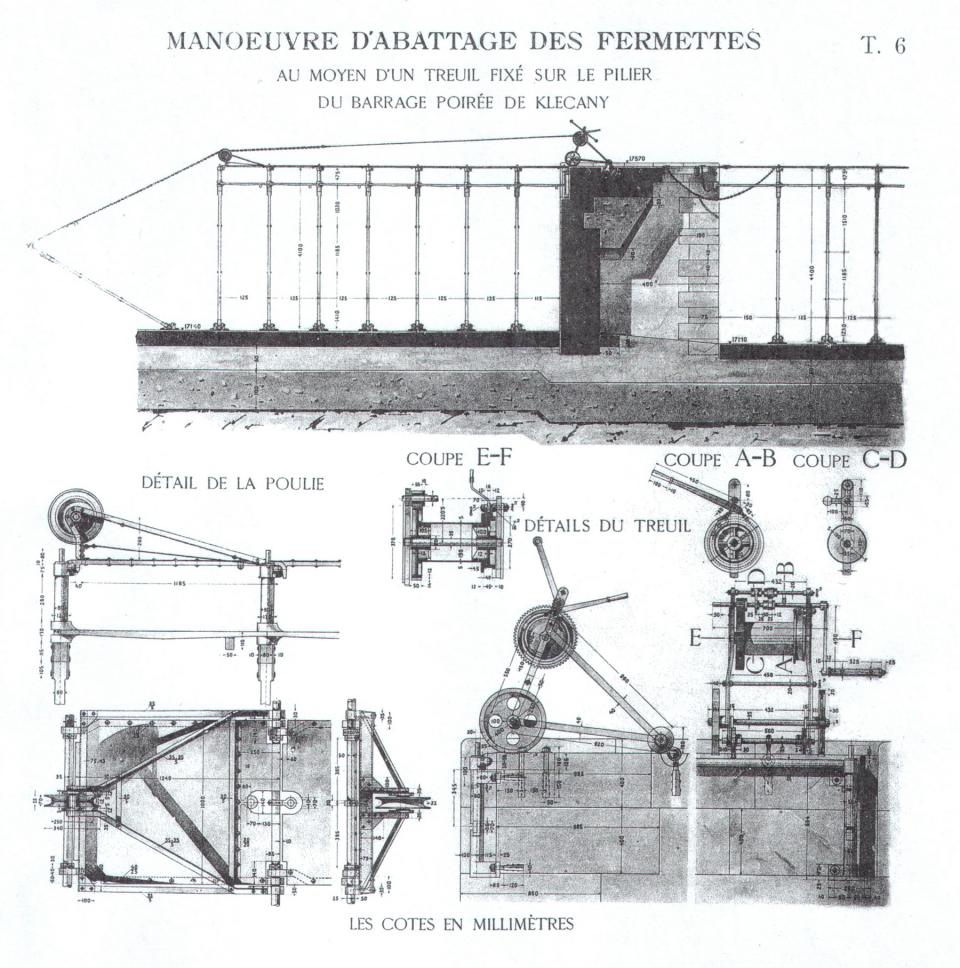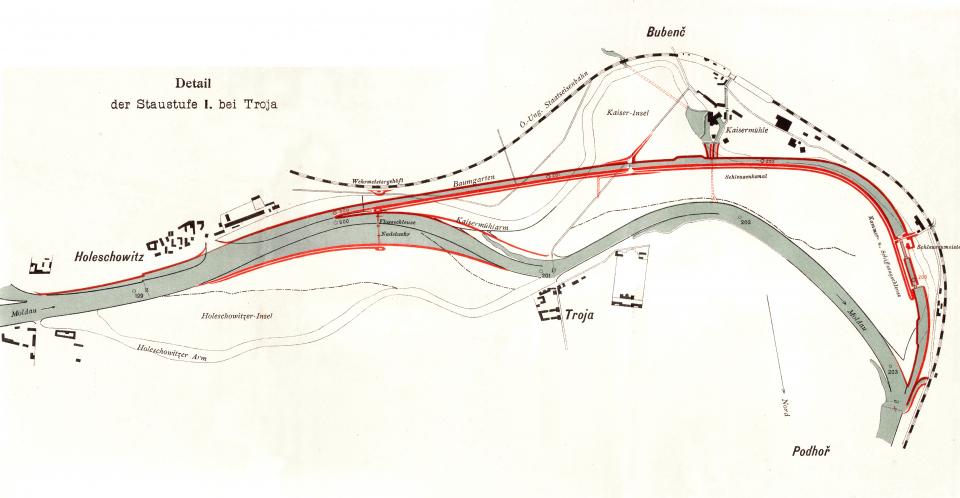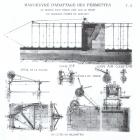In the second half of the nineteenth century, projects aimed at improving ship-based commerce by connecting various rivers boomed. One such project was the establishment of an Elbe-Vltava-Danube canal, which, however, was never completed.

Poster with the construction plans of the dam near Klecan (Paris International Exposition 1900)
Poster with the construction plans of the dam near Klecan (Paris International Exposition 1900)
Image source: Rubin, Wenzel. Die Canalisirung des Moldau- und Elbe-Flusses in Böhmen. Ihre Entwicklung und ihr Stand zu Beginn des Jahres 1900. Prag: 1900.
 This work is licensed under a Creative Commons Public Domain Mark 1.0 License.
This work is licensed under a Creative Commons Public Domain Mark 1.0 License.
A connection to the Danube was a fanciful dream beyond the capacities of engineers at the time. Only a canal suitable for shipping between the Vltava and Elbe was built between Prague and Usti nad Labem.

Map of the area between Vienna and Budweis with three canalisation-projects
Map of the area between Vienna and Budweis with three canalisation-projects
Map modified by Stephan Brabec 2009
 Map source: Deutsch-Österreichisch-Ungarischer Verband für Binnenschiffahrt, Berlin: Verbands-Schriften, 1897–1911.
Map source: Deutsch-Österreichisch-Ungarischer Verband für Binnenschiffahrt, Berlin: Verbands-Schriften, 1897–1911.
 This work is licensed under a Creative Commons Attribution-NonCommercial-ShareAlike 3.0 Unported License.
This work is licensed under a Creative Commons Attribution-NonCommercial-ShareAlike 3.0 Unported License.
The construction project was approved in 1895, and work began in 1897. A commission for the channeling of the Vltava and Elbe River in Bohemia was created, which dutifully reported on problems and successes from 1897 to 1912. Economic interests were the main driving force for this comprehensive transformation of river landscapes into an “Organic Machine” (White 1995); flood protection played no role. Low water tables had been a hindrance for ship and raft transportation alike; the canal promised reliable water levels throughout the year. Sluices and dams were built in Prague, Troja, Klecan, Libschitz, Miřowitz, and Wraňan/Hořin on the Vltava River, and on the Elbe in Beřkowic, Wegstädtl, Raudnitz, Leitmeritz, and Lobositz.

Detailed plan of the barrage near Troja
Detailed plan of the barrage near Troja
Map modified by Stephan Brabec 2009
 Map source: Bericht der Commission für die Canalisierung des Moldau- und Elbe-Flusses in Böhmen über ihre Thätigkeit vom Zeitpunkte ihrer Constituirung am 23. November 1896 bis zum Schlusse des Jahres 1897. Prag : Commission für die Canalisierung des Moldau- und Elbe-Flusses in Böhmen, 1898.
Map source: Bericht der Commission für die Canalisierung des Moldau- und Elbe-Flusses in Böhmen über ihre Thätigkeit vom Zeitpunkte ihrer Constituirung am 23. November 1896 bis zum Schlusse des Jahres 1897. Prag : Commission für die Canalisierung des Moldau- und Elbe-Flusses in Böhmen, 1898.
 This work is licensed under a Creative Commons Attribution-NonCommercial-ShareAlike 3.0 Unported License.
This work is licensed under a Creative Commons Attribution-NonCommercial-ShareAlike 3.0 Unported License.
The canal was never an economic success. Shipping statistics between 1882 and 1916 show that, from the beginning of the twentieth century, the number of transport vessels actually sank. Rafts had to be towed as the flow of the water had been diminished. The construction never fulfilled the hopes placed upon it. World War I meant the end of the project, which, however, had a lasting effect on river ecosystems. Most of the buildings are still in place; only locks and sluices were modernized. After World War II, the integration of water power plants or kayak courses added new forms of use.

Comparison of the raft sluice in Raudnitz 1912 (left photo) and the situation in 2009 (right photo)
Comparison of the raft sluice in Raudnitz 1912 (left photo) and the situation in 2009 (right photo)
Left image  Historic photo modified by Stephanc Brabec 2009
Historic photo modified by Stephanc Brabec 2009
Image source (historic photo):  XIV., XV. und XVI. Jahresbericht der Kommission für die Kanalisierung des Moldau und Elbeflusses in Böhmen über ihre Tätigkeit in den Jahren 1910, 1911 und 1912 Prag: Kommission für die Kanalisierung des Moldau- und Elbeflusses in Böhmen, 1913.
XIV., XV. und XVI. Jahresbericht der Kommission für die Kanalisierung des Moldau und Elbeflusses in Böhmen über ihre Tätigkeit in den Jahren 1910, 1911 und 1912 Prag: Kommission für die Kanalisierung des Moldau- und Elbeflusses in Böhmen, 1913.
Right image: The raft sluice was modified into a kayak course.  2009 Stephan Brabec
2009 Stephan Brabec
 This work is licensed under a Creative Commons Attribution-NonCommercial-ShareAlike 3.0 Unported License.
This work is licensed under a Creative Commons Attribution-NonCommercial-ShareAlike 3.0 Unported License.
How to cite
Brabec, Stephan. “Transforming Rivers into Streets: How the Nineteenth Century Scheme to Improve Shipping on the Vitava, Elbe and Danube Failed.” Environment & Society Portal, Arcadia (2011), no. 7. Rachel Carson Center for Environment and Society. https://doi.org/10.5282/rcc/3399.
ISSN 2199-3408
Environment & Society Portal, Arcadia
 This work is licensed under a Creative Commons Attribution-NonCommercial-ShareAlike 3.0 Unported License.
This work is licensed under a Creative Commons Attribution-NonCommercial-ShareAlike 3.0 Unported License.
2011 Stephan Brabec
This refers only to the text and does not include any image rights.
Please click on the images to view their individual rights status.
- Brabec, Stephan. Die Kanalisierung von Moldau und Elbe: Die Umgestaltung von Fließgewässern aus umwelthistorischer Sicht. Saarbrücken: VDM Verlag, 2011.
- White, Richard. The Organic Machine: The Remaking of the Columbia River. New York: Hill and Wang, 1995.








